Sporting legends are made on the pitch, but the people behind the hallowed turf have as much enthusiasm as those playing.
“Turf. I’m passionate about turf,” Damian Hough says.
“I’m building this pitch for my team … our staff have a love affair for Adelaide Oval.”
Mr Hough has been Adelaide Oval’s head curator since 2010 and is responsible for the playing surface for this week’s Test between Australia and the West Indies.
Watching and waiting for grass to grow might not sound like the world’s most exciting pursuit, but the marriage of leather, willow and grass is what makes summer for Mr Hough.
“I’m pretty fortunate, pretty grateful,” he says.
“I love working outdoors, I love working with turf and I love sport, it’s a combination of my passions.
“I still remember the first day when I walked out there, and the goosebumps of walking out on the hallowed turf.”
What’s in a pitch?
The pitch itself, measuring 25-metres-long, 3-metres-wide and 200-millimetres-deep, has been a labour of love for its curators.
It’s part science, part gut feel, Mr Hough explains.
“The beauty with curating is that it’s a dark art, it’s handed down from curator to curator,” he says.
“I’ve been taught the Adelaide Oval way, which was handed down from Les (Burdett) to me and from Arthur Lance to Les.”
The ground is about 60 per cent clay, and a mix of grasses.
“Cricket pitch characteristics come about through the soil you use, the grass variety that you use and your climatic conditions that you’ve got in the state,” he says.
“The cricket pitches are a couch grass … a warm season couch, and the outfield is a ryegrass.
“We manage a cool-season ryegrass 12 months of the year. That’s what makes a cricket pitch.”
Along with the shared knowledge of the three most recent curators are 420 tonnes of soil from Athelstone, a suburb north-east of Adelaide.
“When Athelstone was subdivided and the suburb was built, [we] got hold of the soil,” Mr Hough says.
“For the developer, it was shocking for him to have this heavy clay material there, and he wanted it gone.
“Les got a hold of it and stored it in the foothills in Highbury.”
So important was this soil, Mr Hough says, that his predecessors and their staff used to hand-dig it out, before transporting it back on a truck.
“So, we know it’s a soil that Arthur was using back in the 50s and 60s, and we know it’s a soil that Les was using when he was here in the 70s, 80s, 90s and early 2000s and we’ve been able to use the same soil,” he says.
An eye on the future
While 70 years of shared history has helped, keeping an eye on changing climate conditions will be integral to its future.
“We manage it the best we possibly can. You’ve always got to have an eye to the future,” he says.
“Whether it is improving irrigation practices, moisture sensors so you understand your moisture levels, harvesting as much water as you possibly can to try to be as sustainable as you possibly can — they’re real things that are going on, you can’t put your head in the sand.
“Species of grass that are drought tolerant or could be salt tolerant.
“Everything that you do, you’ve got to try to live in the now, but at the same time you have got to plan for the short-term, medium-term and long-term and you’re thinking about those things all the time.”
For Mr Hough, embracing modern tools, including x-ray-like technology, has helped take some of the guesswork out of the job.
“The old days it was always about the feel, the touch, a gut feel,” Mr Hough says.
When the covers are pulled back and the pitch is revealed on day one of the Adelaide Test today, Mr Hough says he will try to enjoy the moment, even if he is a little nervous.
“I’m a worrier,” he says.
“Our goal for the game is ten wickets and 300 runs a day which is very, very hard to do.
“I over-analyse: ‘The game’s moving too quick, it’s not moving quick enough’.
“[We want] … the players to shine and produce an entertaining game of cricket.”
Australia will take on the West Indies at Adelaide Oval from 10am local time.
Posted , updated




